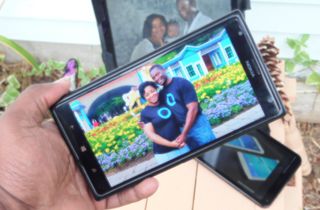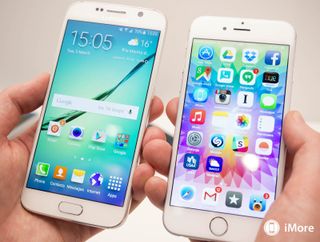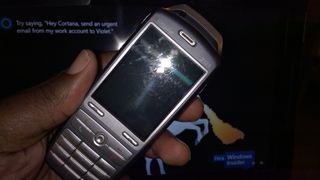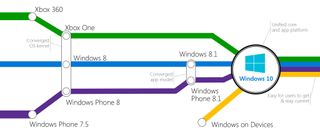What Android and iPhone users need to know about Windows phone
"What's a Windows phone?" That was the response my wife received when she told a coworker the type of smartphone she uses.


Sadly, that wasn't an isolated experience. Several years ago, when Microsoft's mobile platform occupied a larger and consequently more visible (albeit still minuscule) market position, I had a similar encounter.
"Microsoft's making phones now?", was the query I received when I showed a teenager my Windows phone. With a fan's passion, I rose to the defense of Microsoft's mobile efforts, by (pointlessly) educating this whippersnapper on Microsoft's foray into the smartphone arena, long before the iPhone was even a thing. As I said, it was pointless. He had bitten Cupertino's fruit, and like most who partake, he was smitten.

The world of the Android acolyte isn't much different. Like a sailor drawn by a siren's song, consumers have flocked to Samsung's "Next Big Thing," and a galaxy of Android phones provided by a horde of other phone manufacturers.
Many Windows phone fans have had a "What's-a-Windows-phone?" encounter.
With 98 percent of smartphone users hooked on Android or smitten by the iPhone, most are and have been blissfully unaware of Microsoft's mobile efforts throughout the years. Consequently, many Windows-phone fans can likely relate to these "What's-a-Windows -phone?" encounters.
Considering the convoluted evolution of Microsoft's "Windows on phone" vision, explaining Windows phone to someone who only knows iPhone or Android can be challenging. For the uninitiated, the term "Windows phone" may conjure images of start menus, cascading program windows and blue screens of death on a five-inch screen.
Most consumers simply have no idea what "Windows on phone" is, where it's been or where it's going.
A smartphone war vs. mobile war
Sadly, Microsoft has virtually no mindshare among smartphone consumers. What little they acquired through the marketing of smartphones such as the Lumia 900, the Lumia 1020, or the market deluge of low-end phones like the Lumia 520, they're quickly losing.
Get the Windows Central Newsletter
All the latest news, reviews, and guides for Windows and Xbox diehards.
Microsoft is no longer making Lumias, and the marketing of its smartphones has long been nonexistent. Those ads of the past are but a distant footnote in the record of the "Windows-on-phone" journey. So as Microsoft loses more Windows phone fans to the iPhone and Android, a negligible sum is being added to the less than one percent of us who remain. As the old saying goes, out of sight out of mind.
But Microsoft doesn't seem to mind. It seems content to bleed users and developers from its passionate and vocal fan base. The question is, why? The likely answer: collateral damage.
Though Microsoft has conceded the "smartphone war" and has pulled its first-party devices off the battlefield, it has not conceded the "mobile war."
Microsoft lost the "smartphone war." Now it's waging a post-smartphone "mobile war."
From Microsoft's perspective, the smartphone and mobile wars are two different things. And Redmond is just getting started – again. Make no mistake, mobile computing with the full power of Windows on pocketable telephony-enabled devices has long been Microsoft's goal and strategy. Though various stages of that strategy's execution were not met with success, Microsoft's "Windows-on-phone" journey persists and is closer to that goal than ever. The post-smartphone mobile war will be waged with such a device.
For those asking, "What's a Windows phone?", I submit that it has been many things and borne many names, and its evolving journey isn't over. Let's go back to the beginning so that we can more clearly see where things have been, where they are now and where Microsoft is going from here.
Windows Mobile and Pocket PC beginnings

Microsoft's early forays into pocketable mobile computing go back to Pocket PC 2000 which was based on Windows CE and debuted in the 1990s. It was essentially Microsoft trying to put a scaled-down version of Windows in our pockets. It was a bit clunky and not especially intuitive, but powerful for its day.
The Pocket PC moniker continued with Pocket PC 2002 until Windows Mobile 2003 which was succeeded by Windows Mobile 2003 SE. Windows Mobile 5.0 followed, and like its predecessors, it brought elements of the Windows desktop to a pocketable device.
The Cingular 2125, which was powered by Windows Mobile 5.0, was my first Windows phone in 2006.

What might surprise the young man with whom I spoke who found Microsoft's involvement in the smartphone space odd, and my wife's coworker, is that in 2007, Windows Mobile had 42 percent of the smartphone market.
Of course, the smartphone space was business-focused and the realm of techies at the time. It was a world that coexisted with but was invisible to regular consumers. That's until Apple "redefined" the space that same year with the touch-friendly, consumer-focused iPhone. Things went downhill for Microsoft from there.
Windows Mobile 6, 6.1 and 6.5 followed 5.0 and ended (for a time) the "Windows Mobile" designation, and "Windows Phone" became the moniker for Microsoft's "rebirthed" mobile efforts in 2010.
Windows Phone, a platform reborn
Windows Phone was a touch-friendly reset of Microsoft's mobile OS and UI in response to the iPhone's and Android's dominance of the consumer smartphone space. The heavy PC-like, and stylus-dependent legacy was forsaken.
Moreover, Windows Phone 7 broke ranks with its OS predecessors as previous apps no longer worked with the new platform, many PC-like features such as access to the file system were lost, and the openness of the platform power users loved was replaced with an iPhone-like, you-get-what-we-give-you platform.
Many power users, lured by the openness of Android, gave up on Microsoft's "Windows on phone" vision after Windows Phone's introduction revealed an abandonment of what many fans of Windows Mobile loved. I was almost one of them.
Windows Phone 7.5, with the 500 additional features Microsoft brought to the OS, and the HTC Titan eventually won me over to Microsoft's latest OS. I chose it over the Samsung Galaxy Note and was quite pleased with my choice.

Microsoft's pocket PC dreams and its path to a unified Windows platform across form factors, OneCore, led to another disruption to users and developers, however. Millions of users (including me) were left with Windows Phone 7.5 devices that could not transition to the latest and greatest "Windows-on-phone" OS that was whetting our appetites: Windows Phone 8.
There was no upgrade path to Windows Phone 8.
I understood that minimum hardware requirements wouldn't allow an upgrade, so I wasn't too bothered. At least not until I found that my HTC Titan couldn't get the stop-gap upgrade, "Windows Phone 7.8", that Microsoft released to pacify users. I was not pleased.
I eventually got the Windows Phone 8-powered Lumias 1020 and 1520. I was delighted again. That is until Microsoft's OneCore journey robbed my 1520 of some of my favorite features when I upgraded to Windows Phone 8.1. Though we got Cortana and a host of other goodies, many fans shared my pain as we lost some of Windows Phone's most endearing features. (I told you the "Windows-on-phone" journey was convoluted.)
But these were sacrifices made in the name of progress, and OneCore was coming, so we marched on to Redmond's beat. Well, not completely ... my 1020 still runs Windows Phone 8.
Perfect 10, Windows on "phone" within ARM's reach

Eventually, Windows 10 Mobile arrived for those of us who are part of the Insiders Program and those who bought the Lumias 950 and 950 XL. Having achieved OneCore, Windows 10 Mobile shares the same core as the Windows 10 desktops hundreds of millions of iPhone and Android phone consumers use today.
Most smartphone consumers are unaware that their PC OS and Microsoft's mobile strategy are connected.
Most of these consumers have little to no knowledge of the universal platform binding their PCs with the "Windows-on-phone" mobile strategy Microsoft has been working toward for years. Microsoft's early iteration of that vision, Pocket PC 2000, brought certain elements of desktop Windows to a pocketable mobile device, but the platforms were still separate.

Today, the Universal Windows Platform's (UWP) shared core and Microsoft's recently announced full Windows on ARM bring Redmond within arm's reach of the full realization of the company's "Windows-on-phone" vision.
Just as Microsoft's "Windows-on-phone" journey has been invisible to many smartphone consumers to this point, the shift from a lost smartphone war to the waging of a post-smartphone mobile war, is invisible to many, as well. Given Microsoft's failures in the smartphone space, many Microsoft watchers doubt their future success in mobile.
The Continuum-powered ultra-mobile PC with telephony – the device beyond the smartphone – will not be measured by the old iteration-focused smartphone rules that governed the past ten years, however. Will it matter?
Microsoft's changing the game right under our noses
The iPhone-and-Android world is focused on yearly iterative improvements to hardware specs and minor software enhancements. What if their expectations were shifted away from such things as what type of glass the next iPhone's display will have toward something more comprehensive and encompassing?

The mobility of a user's experience facilitated by an intelligent cloud and accessed through pocketable, context-conforming hardware and software, or a pocket PC that shares the same OS as a family of devices, that could be a full PC, a tablet and a smartphone, would likely draw their attention.
If Apple or Google announced such a device, iPhone and Android fans would probably proclaim that these companies changed the game. In the shadows of obscurity, invisible to the masses, it is Microsoft that is doing just that.
Through its UWP and Continuum, Redmond has created a platform for 3-in-1s like the HP Elite x3 that is a tablet, PC and smartphone, that runs mobile apps and through virtualization, Win32 apps. Based upon this foundation, Microsoft is poised to launch an ultimate mobile (Windows on phone) device.
So what is a Windows phone?
In truth, it is a concept in flux as Microsoft works toward the full Windows-on-phone goal. Windows Mobile, Windows Phone, and even Windows 10 Mobile on devices such as the Elite x3 are iterative steps toward the true "Windows-on-phone" vision.
Windows phone is the evolving journey of Windows on phone.
In the spirit of the category-defining Surface, a Windows "phone" will define a category and be more than just a phone, PC or tablet. It will be all these things. Ultimately a Windows phone will be a pocketable, context-conforming, telephony-enabled ultramobile PC running full Windows 10 on ARM.
Through the power of Continuum, users will be able to use it as a desktop PC.
It will run both UWP and Win32 apps. Furthermore, Microsoft's adaptive shells will ensure that though the OS will be full Windows 10, the user interface on the small screen will be touch and mobile-friendly.
Dear iPhone and Android phone users ...
iPhone and Android fans, Windows phone fans are so enamored with the Windows-on-phone vision because we know Microsoft's coming device will be much more than a phone. As Windows PC users you too may find the realization of Microsoft's vision equally appealing.
Later this year Microsoft's partners will introduce ARM-based, always-connected cellular PCs running full Windows 10 to the public. Consequently, Redmond will begin gaining mindshare for cellular-connected Windows 10 PCs among the iPhone and Android phone using public. These Windows 10 devices will have APIs for Windows Holographic, inking capabilities and more features common to the platform.
This strike in the mobile war, I believe – (along with much-needed ecosystem investments) – will be Microsoft's segue to the ultramobile Surface, or the realization of the "Windows-on-phone" vision. Will Redmond incorporate inking, mixed-reality and other Microsoft innovations on this ultramobile Surface? We'll see.
I am confident that once Microsoft launches what fans call a Surface phone, I call an ultramobile PC, and CEO Satya Nadella calls an ultimate mobile device, Redmond will have crafted a name and message that conveys the positioning of this "device that is beyond a smartphone."
In the meantime, Windows-phone fans should take heart and pin this link as a Live Tile to their Start screens. (Yeah, you can do cool stuff like that on a Windows phone ... but not an iPhone).

And the next time someone asks you, "What's a Windows phone?", you can tap that Live Tile and share the link as you say with a smile, "I'm glad you asked."
Following the story
Windows phone isn't dead
- If Microsoft doesn't kill at BUILD 2017, the Surface phone may be dead on arrival
- Is early 2018 too early for a Surface phone?
- Will Samsung beat Microsoft to market with an ultimate Mobile device?
- Did Microsoft give us a glimpse of its Surface phone vision
Smartphones are dead
The untold app gap story
Windows Mobile and the enterprise
I'm a Windows phone fan in an iPhone/Android world. Why? Microsoft has it going on!
The Surface Phone
Jason L Ward is a columnist at Windows Central. He provides unique big picture analysis of the complex world of Microsoft. Jason takes the small clues and gives you an insightful big picture perspective through storytelling that you won't find *anywhere* else. Seriously, this dude thinks outside the box. Follow him on Twitter at @JLTechWord. He's doing the "write" thing!

